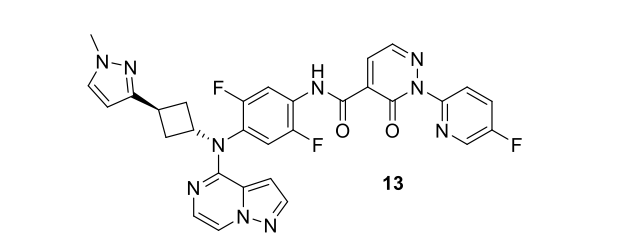By Mark Stewart (Group Leader, Chemistry)
A team from Pfizer has reported on a series of pyrazolopyrazines which have demonstrated intracranial efficacy in mouse models1. The team targeted the receptor tyrosine kinase, mesenchymal-epithelial transition factor (MET), via type II orthosteric inhibition. Screening hits were prioritised based upon topological polar surface area (TPSA) and hydrogen bond donor count, to maximise the likelihood of central nervous system (CNS) exposure. Their optimisation strategy explored three areas of the ligand to identify potent inhibitors (against both wild type and mutant forms) with good pharmacokinetic (PK) properties and an in vivo profile suitable for oral administration. Compound 13 (Figure 1) was selected as the lead compound to undergo further studies.

Figure 1: The structure of Compound 13
A cocrystal structure of 13 binding to MET D1228N was solved to 1.59Å resolution, revealing a mixture of classic hydrogen bonding, water mediated hydrogen bonds (including one which stabilises a perpendicular biaryl geometry of the ligand), a non-classical C-H hydrogen bond to the hinge (postulated), as well as a π-stack to the DFG motif through the difluorophenyl motif.
Compound 13 exhibited very good kinase selectivity, only significantly inhibiting five kinases out of a panel of 396 tested, and importantly dialled out VEGFR-2 inhibition (a common off-target amongst type II MET inhibitors). In MDCK II cell permeability assays, little to no efflux was identified across the series. 13 demonstrated a good in vivo PK profile when dosed po at 30 mg/Kg, maintaining plasma concentrations that exceeded the IC90 value out to 12 hours post dose. Pharmacodynamic investigations demonstrated near-complete inhibition of phospho-MET for a minimum of 12 hours post dose.
Anti-tumour efficacy at 30 mg/Kg BID was observed, and the survival rate of mice following a 100 mg/Kg (QD) dose was maintained at 100% up to day 80 of the study. Bioavailability values exceeded 200% in mouse, suggesting saturation and/or recirculation mechanisms at play. Whilst the compound only exhibited a modest Kp,uu of 0.11, this metric increased to 0.24 upon dose escalation to 100 mg/Kg. With CNS exposure observed, the team demonstrated in vivo antitumor efficacy, administering compound to mice bearing intracranial tumours expressing an exon 14 skipping alteration and a MET-D1228N P-loop mutation.
This project is yet another example of a medicinal chemistry programme that targets kinases within the CNS, a growing area of interest of late. The series however was ultimately discontinued due to time-dependent inhibition (TDI) of Cyp 3A4. This unpredictable outcome is especially unfortunate considering the kinome selectivity profile and strong anti-tumour efficacy observed for Compound 13 within mouse models.
At Domainex we have extensive CNS experience and have established CNS workflows in place (such as MPO calculators, EPSA measurements and Kp,uu predictors) to try to maximise the likelihood of CNS exposure during our molecular design work. Please get in touch if you would like to find out more.
Reference:
- Quinn A. Bumpers, Robert W. Pipal, Anna M. Benz-Weeden, James T. Brewster II, Adam Cook, Amy L. Crooks, Cole Cruz, Natalie C. Dwulet, John J. Gaudino, Daniel Golec, Jacqueline A. Harrison, Dylan P. Hartley, Sherif H. Hassanien, Erik J. Hicken, Dean Kahn, Ellen R. Laird, Christine Lemieux, Nicholas Lewandowski, Joseph McCown, Matthew G. McDonald, Oren McNulty, Tung-Chung Mou, Phong Nguyen, Lauren Oko, Lisa Pieti Opie, Jennifer Otten, Spencer C. Peck, Viktor C. Polites, Samuel D. Randall, Rachel Z. Rosen, Pavel Savechenkov, Helen Simpson, Anurag Singh, Drew Sparks, Kyle Wickersham, Lance Wollenberg, Christina E. Wong, Jim Wong, Wen-I Wu, Mohamed S. A. Elsayed, Ronald J. Hinklin, and Tony P. Tang. Discovery of Pyrazolopyrazines as Selective, Potent, and Mutant-Active MET Inhibitors with Intracranial Efficacy. Journal of Medicinal Chemistry, 2024 67 (16), 14466-14477